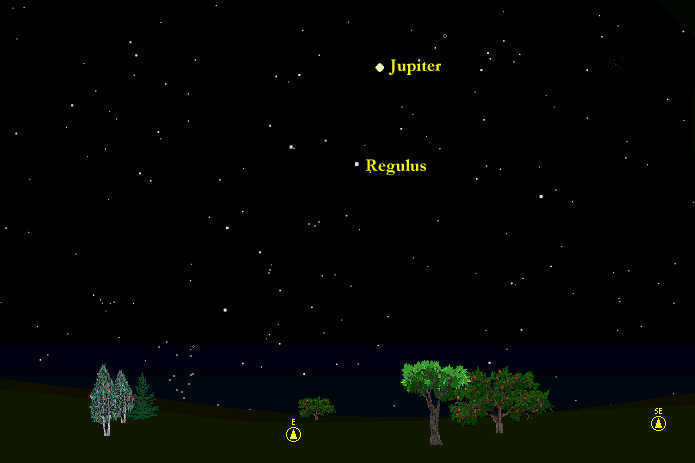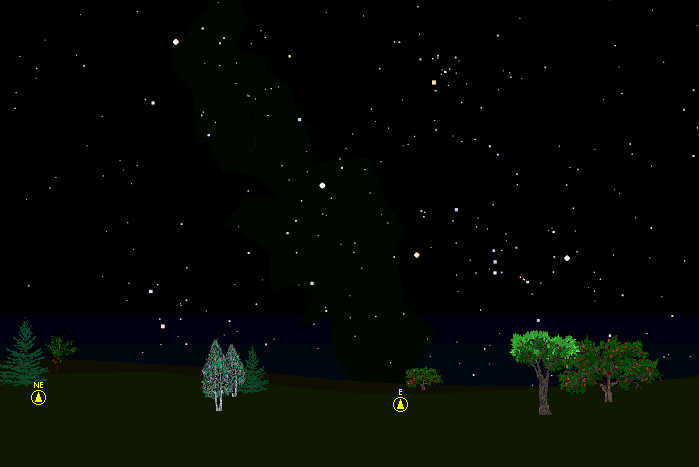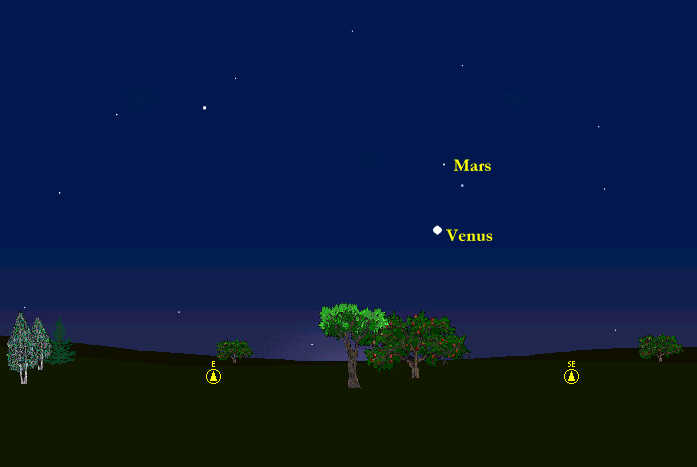The purpose of this new feature is to give scout leaders, educators and naturalists an idea of some of the natural events coming up each month. We will try to cover a variety of natural events ranging from sky events to calling periods of amphibians, bird and mammal watching tips, prominent wildflowers and anything else that comes to mind. We will also note prominent constellations appearing over the eastern horizon at mid-evening each month for our area for those who would like to learn the constellations. If you have suggestions for other types of natural information you would like to see added to this calendar, let us know! Note: You can click on the hyperlinks to learn more about some of the featured items. To return to the Calendar, hit the "back" button on your browser, not the "back" button on the web page. Sky Events: The Leonid Meteor Shower Set your alarm for the early morning hours of November 19th. The Leonids are back (see our Nature Notes page, “A November Tradition”) and this is the last year for some time that we have the possibility of a meteor “storm”. The number of meteors seen per hour could be as high as several thousand, but a full moon will cut down on the number that are visible. The predicted peak of the shower is 4:36am CST on the morning of the 19th. We advise getting up at least by 2:00am and watching till dawn. Some tips:
The figure below shows the sky looking east at 2:00am on November 19th, 2002, the morning of the Leonid Meteor Shower. If you're looking toward the bright planet Jupiter, you're looking in the right direction for the meteor shower. Regulus is the brightest star in the constellation Leo, at the bottom of the handle of the "sickle." Because of the full moon you will not see many of the fainter stars shown.
Evening Sky: This November is a great time to learn some of the beautiful fall constellations that rise in the early evening. Watch for Saturn to rise around 7:00pm CST. Saturn's rings are open quite wide and the planet is stunning even in a small telescope. Jupiter rises around 10:45pm CST. The two figures below show the sky looking east at 9:00pm CST on November 15th. Keep in mind that if you do not have a flat horizon you may have to wait a little longer before the constellations clear your tree line. Also, keep in mind that if you're in the city, light pollution will keep you from seeing some of the fainter stars.
The figure below shows the same view with the constellations and Saturn labeled. Constellation names are shown in green. Bright star and planet names are shown in yellow and red.
Morning Sky: At mid-month Mars rises about 3:45am CST. Bright Venus rises about 4:45am CST. See if you can see Venus's slender crescent in binoculars. To do so, you will probably need to steady your arms against something while looking. The view will actually improve as the sky gets brighter and the contrast is not as great. Beware the rising sun. Never allow your binoculars to come anywhere near the sun. If you accidentally sweep across the solar disk, you can permanently damage your eyes. Persons with extremely good eyesight sometimes report being able to spot the crescent Venus with the naked eye. Around midmonth, when the image of the planet is still quite large, is a good time to try this. If you want to improve your chances, try looking through a black piece of paper with a pinhole in it. Although I've never tried this on Venus, the pinhole will improve the image of the planet formed by your eye. Try different size pinholes, from 1mm to 3mm. The figure below shows the sky at 5:45am CST on November 19th.
All times noted in the Sky Events are for Franklin, Tennessee and are Central Standard Time. These times should be pretty close anywhere in the mid-state area. On Learning the Constellations: We advise learning a few constellations each month, and then following them through the seasons. Once you associate a particular constellation coming over the eastern horizon at a certain time of year, you may start thinking about it like an old friend, looking forward to its arrival each season. The stars in the evening scene above, for instance, will always be in the same place relative to the horizon at the same time and date each November. Of course, the planets do move slowly through the constellations, but with practice you will learn to identify them from their appearance. In particular, learn the brightest stars (Like Capella, and Aldebaran in the above scene), for they will guide you to the fainter stars. Once you can locate the more prominent constellations, you can "branch out" to other constellations around them. It may take you a little while to get a sense of scale, to translate what you see on the computer screen or what you see on the page of a book to what you see in the sky. Look for patterns, like the three stars in a line in Orion's belt. The earth's rotation causes the constellations to appear to move across the sky just as the sun and the moon appear to do. If you go outside earlier than the time shown on the charts, the constellations will be lower to the eastern horizon. If you observe later, they will have climbed higher. As each season progresses, the earth's motion around the sun causes the constellations to appear a little farther towards the west each night for any given time of night. If you want to see where the constellations in the above figures will be on December 15th at 9:00pm CST, you can stay up till 11:00pm CST on the November 15th and get a preview. The westward motion of the constellations is equivalent to two hours per month. For instance, if you want to see what stars will be on your eastern horizon on February 15th at 9:00pm CST (3 months later), you would need to get up at 3:00am CST in the morning on November 15th (3 months times 2 hours/month = 6 hours). A good reference book for learning the constellations is the Peterson Field Guide, A Field Guide to the Stars and Planets, by Pasachoff. The book retails for around $14.00. A good beginners software program for learning the night sky is the Starry Night Beginner program. Visit the Starry Night web site at www.starrynight.com The program retails for around $30.00, and contains a wealth of information. Circumzenithal Arcs: Fall, Winter and Spring are good times to watch for these beautiful arcs that form directly overhead. Be sure to look upward in the late afternoon anytime you have wispy cirrus clouds in sky.
Amphibians: We think of November as the quietest time of the year for frogs and toads in Tennessee, with much less calling than the cold winter months. However, you may hear a Upland Chorus Frog doing the very dry sounding fall call. Spring Peepers call sporadically from the trees. Listen for Southern Leopard Frogs, which sometimes have breeding choruses in the fall. Look also for their egg masses and tadpoles in ponds. Many other frogs and toads are still active and can be found by driving the back roads on mild rainy nights. Northern Cricket Frogs can sometimes be found by walking the along creeks or beside wet areas this time of year. Checking around ponds with a flashlight held beside your temple will many times show the eye shine of Southern Leopard Frogs and Bullfrogs this time of year.
Birds: You probably have already put out your bird feeders, but if you haven’t your missing out on a lot of good looks at winter feeder birds. This is a great time of year to start learning your birds. Watch and listen for fall arrivals like White-throated and White-crowned Sparrows, Yellow-bellied Sapsuckers, Red-breasted Nuthatches and Brown Creepers. Once in November, near Rugby, Tennessee, we heard 3 Roughed Grouse drumming on a hike, something we’re used to hearing in early spring. Listen for Great Horned Owl courtship at dusk and dawn. Recommended: The Sibley Guide to Birds, David Allen Sibley For the eastern United States only, A Field Guide to the Birds East of the Rockies, Roger Tory Peterson An inexpensive guide for beginners is the Golden Guide for Birds.
Mammals: Listen for the high-pitched squeaks of flying squirrels in nut-bearing trees at night. They sound a little like the high metallic sounds that steel rails make as a train approaches.
Fruits: November is a great time for all types of wild fruits. This is a great time to grab a field guide and look at acorns, hickory nuts, persimmons and berries. Vines like Moonseed and Snailseed are fruiting and are fun to look at. This is a good time to take your group out and see how many types of fruit that you can locate. Night scenes prepared with Starry Night Pro software
|



